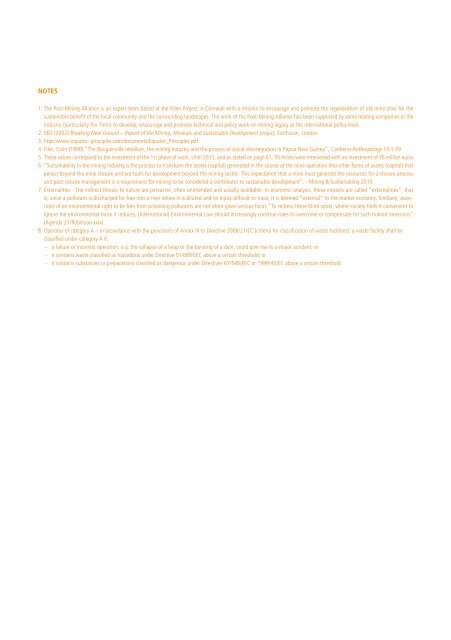Livro EDM
"A Herança das Minas Abandonadas - O Enquadramento e a Situação em Portugal"
"A Herança das Minas Abandonadas - O Enquadramento e a Situação em Portugal"
You also want an ePaper? Increase the reach of your titles
YUMPU automatically turns print PDFs into web optimized ePapers that Google loves.
NOTES<br />
1. The Post-Mining Alliance is an expert team based at the Eden Project in Cornwall with a mission to encourage and promote the regeneration of old mine sites for the<br />
sustainable benefit of the local community and the surrounding landscapes. The work of the Post-Mining Alliance has been supported by some leading companies in the<br />
industry (particularly Rio Tinto) to develop, encourage and promote technical and policy work on mining legacy at the international policy level.<br />
2. IIED (2002) Breaking New Ground – Report of the Mining, Minerals and Sustainable Development project, Earthscan, London<br />
3. http://www.equator- principles.com/documents/Equator_Principles.pdf<br />
4. Filer, Colin (1990) “The Bougainville rebellion, the mining industry and the process of social disintegration in Papua New Guinea”, Canberra Anthropology 13:1-39<br />
5. These values correspond to the investment of the 1st phase of work. Until 2011, and as stated on page 61, 35 mines were intervened with an investment of 76 million euros<br />
6. “Sustainability in the mining industry is the process to transform the assets (capital) generated in the course of the mine operation into other forms of assets (capital) that<br />
persist beyond the mine closure and are tools for development beyond the mining sector. This expectation that a mine must generate the resources for a closure process<br />
and post-closure management is a requirement for mining to be considered a contributor to sustainable development”. - Mining & Sustainability 2010.<br />
7. Externalities - The indirect threats to nature are pervasive, often unintended and usually avoidable. In economic analysis, these impacts are called “externalities”, that<br />
is, since a pollutant is discharged for free into a river where it is diluted and its injury difficult to trace, it is deemed “external” to the market economy. Similarly, assertions<br />
of an environmental right to be free from poisoning pollutants are not often given serious focus.”To redress these blind spots, where society finds it convenient to<br />
ignore the environmental harm it induces, [International] Environmental Law should increasingly construe rules to overcome or compensate for such human omissions”<br />
(Agenda 21/Robinson xxix).<br />
8. Operator of category A – in accordance with the provisions of Annex III to Directive 2006/21/EC (criteria for classification of waste facilities), a waste facility shall be<br />
classified under category A if:<br />
– a failure or incorrect operation, e.g. the collapse of a heap or the bursting of a dam, could give rise to a major accident; or<br />
– it contains waste classified as hazardous under Directive 91/689/EEC above a certain threshold; or<br />
– it contains substances or preparations classified as dangerous under Directives 67/548/EEC or 1999/45/EC above a certain threshold.


